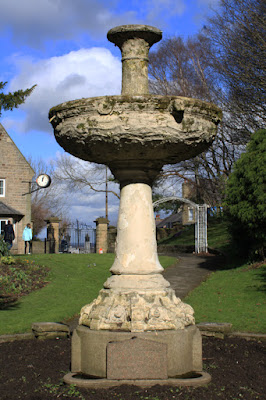 |
| Locke Park Tower |
During my brief walk around Kingstone and Ouslethwaite, the main reason for visiting this part of Barnsley was to see Locke Park, a popular public space that occupies a ridge of Pennine Middle Coal Measures Formation (PMCMF) rocks, which is less than 1 km from the town centre.
I have visited Barnsley numerous times over the years, mainly to see exhibitions at the Cooper Gallery and The Civic, or as a starting place from which to explore the mediaeval churches and historic architecture in some of the surrounding villages. Until quite recently, I had never heard of Locke Park – a gift to the town by Phoebe, the widow of the great railway engineer, Joseph Locke.
Entering by the gates on Park Road I was immediately attracted to a stone lion that is placed on a plinth near to the entrance to Serpentine Walk. Presumably made of Portland stone, these were brought from Cawthorne in 2019 to replace others that had been removed in the 1970’s.
The focal point of the Serpentine Walk, through a landscaped old quarry in the Kent’s Rock, is a large stone ornamental fountain (1877), which has either been painted or covered in a very thick coat of limewash, which detracts from its appearance.
The fountain is now filled with soil and used as a planter and the stone from which it has been built deserves further investigation; furthermore, a particularly interesting feature here is the set of four inscribed plaques on its base, which are made of Shap granite.
At the southern end of the Serpentine Walk is another stone lion, along with another example of Shap granite in the form of a glacial erratic, which was found in Royston and eventually brought to the park by the Barnsley Naturalist Society; however, on this occasion, I did not see any information about this or the ABC steps and was therefore completely unaware of them.
Continuing my exploration of the park, I was interested to see the four Ionic columns that have been located on the higher ground above the landscaped quarry. These came from the old bank and post office at the corner of Church Street and Royal Street, which was demolished to make way for a new building.
The centrepiece of the park, set on its highest point, is the Grade II* Listed Locke Park Tower (1877) by Richard Phené Spiers - a London architect that I had never heard of before – which was paid for by Sarah McCreery, the sister of Phoebe Locke.
Although surrounded by a high hedge, with a locked gate to prevent me from getting close to the tower, I could clearly see from a distance that the building stones used in its construction are not locally quarried PMCMF sandstones.
The structure is mainly built with Jurassic Ancaster limestone from Lincolnshire, with its very distinctive ripple marks, which has decayed badly and has been restored in several places. Permian Red Mansfield stone, a sandy variety of the Cadeby Formation, has been used for the band courses and terracotta for the Corinthian capitals and the richly decorated frieze below the viewing platform.
After photographing the Grade II Listed bandstand for the British Listed Buildings website, I made my way back towards the Park Road entrance and briefly stopped to photograph the statue of Joseph Locke by Baron Carlo Marochetti and its enclosure, which was commissioned by the Institute of Civil Engineers and unveiled in 1866.
The bronze statue sits on a plinth of pink Peterhead granite from Aberdeenshire, with Historic England describing it as being "surrounded by a square enclosure with a Portland stone balustrade
with turned balusters and square, panelled corner piers with ornamental
square capitals".
I finished my brief exploration of Locke Park by quickly looking around the area near to the pavilion café, where an ornamental drinking fountain - moved to the park in 1866 from Peel Square in Barnsley - provides another interesting detail in the park, like those that could once be seen at Boston Park in Rotherham.
Next to the children’s playground, a large plesiosaur like creature with a dragon's head, is made of nine separate carved segments. It is apparently called Silurian Stone, but I have yet to find out anything about this fine modern addition to a wonderful Victorian park.


















































